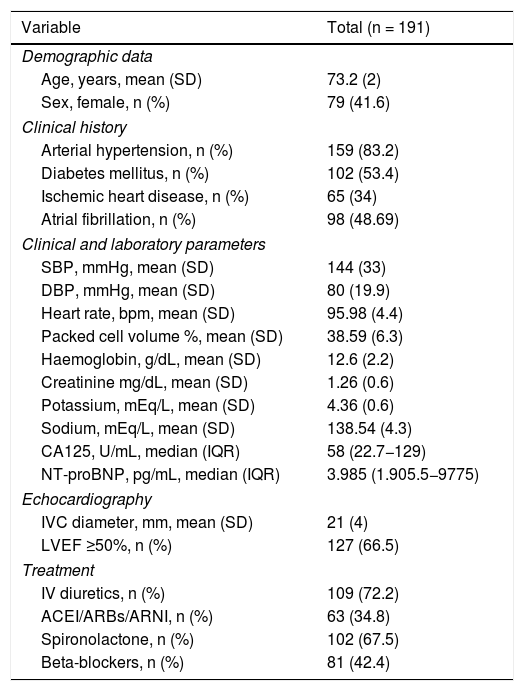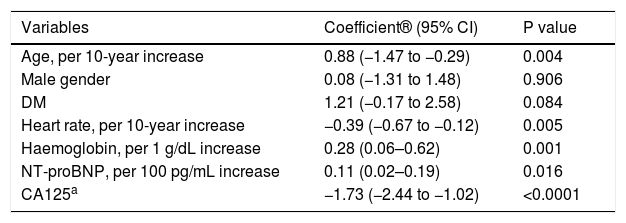Carbohydrate antigen 125 (CA125) and B-type natriuretic peptides are surrogate markers of congestion in patients with acute heart failure (AHF). The aim of the study was to assess the association between CA125 and NT-proBNP and congestion parameters in patients with AHF.
Methods and resultsProspective multicentre observational study that included 191 patients hospitalised for AHF. We recorded the presence of pleural effusion, peripheral oedema and inferior vena cava (IVC) diameter during the first 24–48 h after admission and evaluated their independent association with CA125 concentrations and the amino-terminal fraction of pro-B-type natriuretic peptide (NT-proBNP). The mean age was 73.4 ± 12 years, 79 (41.4%) were women, and 127 (66.5%) had left ventricular ejection fraction ≥50%. The median of CA125, NT-proBNP and IVC diameter was 58 (22.7–129) U/mL, 3,985 (1,905–9,775) pg/mL and 21 (17–25) mm, respectively. Multivariate analysis showed that CA125 was positively and independently associated with the presence of peripheral oedema, pleural effusion and elevated IVC levels. NT-proBNP was associated with pleural effusion and IVC diameter but not with oedema. The addition of CA125 increased the discriminatory capacity of the baseline model to identify peripheral oedema and pleural effusion, but not NT-proBNP. The most important predictor of ICV dilation was CA125 (R2 = 48.3%).
ConclusionIn patients with AHF, serum CA125 levels are associated more significantly than NT-proBNP with a state of congestion.
El antígeno carbohidrato 125 (CA125) y los péptidos natriuréticos tipo B son marcadores subrogados de congestión en pacientes con insuficiencia cardíaca aguda (ICA). El objetivo del estudio fue valorar la asociación entre CA125 y NT-proBNP y parámetros de congestión en pacientes con ICA.
Métodos y resultadosEstudio observacional prospectivo multicéntrico, que incluyó a 191 pacientes hospitalizados por ICA. Se registró la presencia de derrame pleural, edema periférico y diámetro de vena cava inferior (VCI) durante las primeras 24–48 horas tras el ingreso y se evaluó su asociación independiente con las concentraciones de CA125 y la fracción amino-terminal del péptido natriurético tipo B (NT-proBNP). La edad media fue de 73,4 ± 12 años, 79 (41,4%) eran mujeres y 127 (66,5%) tenían fracción de eyección ventricular izquierda ≥50%. La mediana de CA125, NT-proBNP y diámetro VCI fue de 58 (22,7–129) U/mL, 3.985 (1.905–9.775) pg/mL y 21 (17–25) mm, respectivamente. El análisis multivariante mostró que el CA125 se asoció positiva e independientemente con presencia de edema periférico, derrame pleural y valores elevados de VCI. El NT-proBNP se relacionó con el derrame pleural y el diámetro de VCI, pero no con el edema. La adición del CA125 incrementó la capacidad discriminativa del modelo basal para identificar edema periférico y derrame pleural, no así el NT-proBNP. El predictor más importante para la dilatación de la VCI fue el CA125 (R2 = 48,3%).
ConclusiónEn pacientes con ICA, los niveles séricos de CA125 se asocian de forma más significativa que los de NT-proBNP con el estado de congestión.












